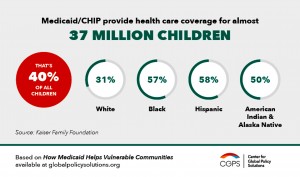Medicaid provides health coverage for 57 percent of Black children
10th July 2017 · 0 Comments
By Dawn Godbolt, Ph.D.
Contributing Writer
(Special from NorthStarNews Today) — Medicaid plays a significant role in providing health care to communities of color and reducing health disparities. People of color tend to be covered by Medicaid at a higher rate than whites, often because they face structural disadvantages, which result in less access to private health insurance. Examples of these barriers include lower levels of education and higher unemployment rates. Given the fact that minorities also tend to fare worse on health measures than whites, Medicaid’s role in furnishing invaluable.
Medicaid and the Children’s Health Insurance Program (CHIP) cover a large portion of minorities: roughly 28 percent of Black adults and 57 percent of Black children, 25 percent of Hispanic adults and 58 percent of Hispanic children, 33 percent of Native Hawaiian and other Pacific Islanders, and 26 percent of American Indian and Alaska Native (AIAN) adults, and 50 percent of AIAN children.
Native Americans and Alaskan Natives receive healthcare through Indian Health Services (IHS), a federal program that has been grossly underfunded since its inception. Given the limitations of IHS, Medicaid is vital to American Indians and Alaska Natives. In fact, one in three out of five million American Indian and Alaska Natives are covered by the program. In an effort to reduce health disparities, the Centers for Medicaid and Medicare Services expanded its coverage for AIANs to include 100 percent reimbursement to states for any Medicaid benefits received.
People of color had the largest increases in coverage with the implementation of the Affordable Care Act (ACA), but even with the Medicaid expansion, people of color are more likely to lack coverage than Whites. Minorities make up 55 percent of the 33 million uninsured Americans, and American Indians and Alaskan Natives and Hispanics are most likely to be uninsured.
Despite the ACA and the expansion of Medicaid, there is still a coverage gap.
In states that did not expand Medicaid, many people remain uncovered because they do not meet the eligibility requirements for the Health Insurance Marketplace tax credits. Many African Americans fall into the coverage gap because their population tends to be concentrated in the South, where most states chose not to expand Medicaid.
Dr. Dawn Godbolt, Ph.D. is with the Center for Global Policy Solutions. The above is an excerpt from the article: Medicaid: America’s Largest Health Insurer.
This article originally published in the July 10, 2017 print edition of The Louisiana Weekly newspaper.



